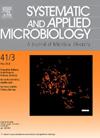盐湖植物菌门的第一个代表——水解钠藻
IF 4.2
2区 生物学
Q2 BIOTECHNOLOGY & APPLIED MICROBIOLOGY
引用次数: 0
摘要
尽管对苏打湖微生物群落进行了大量的微生物学表征,但尚未从这些盐碱生境中分离出植物菌门的可培养代表。在研究苏打湖微生物群落对多糖利用的背景下,我们在好氧、中等盐碱性条件下(1 M总Na+, pH 9.5),以多糖透明质酸为富集底物。结果在纯培养中选择性富集和分离了属plantomycetotta的菌株AB-hyl4。细胞是微小的运动球菌,生长在大的集合体中,具有革兰氏阴性型的超微结构,并产生黄色色素。这种专性好氧解糖异养菌的生长底物范围极窄,除了透明质酸外,还包括密兹糖和甘油。膜脂由磷脂酰胆碱和两种中性脂组成,包括类hopoid和单不饱和C17和C19碳氢化合物。系统基因组学分析表明,该分离物作为一个新的属级谱系,属于物理科物理纲。它的基因组包含一个编码多糖裂解酶的基因,该基因来自PL8家族,可能负责透明质酸降解为二聚体,然后在周质中转运和水解成单体,最后在细胞质中糖酵解降解。根据菌株AB-hyl4T (DSM 117794 = UQM 41914)不同的表型和基因组特性,建议将其归类为natronommicrosphaera hydrolytica gen. nov., sp. nov.。本文章由计算机程序翻译,如有差异,请以英文原文为准。
Natronomicrosphaera hydrolytica, gen. nov., sp. nov., a first representative of the phylum Planctomycetota from soda lakes
Despite intensive microbiological characterization of soda lake microbial communities, no culturable representatives from the phylum Planctomycetota have been isolated from these haloalkaline habitats. In the context of studying polysaccharide utilization by soda lake microbial communities, we used polysaccharide hyaluronic acid as enrichment substrate at aerobic, moderate haloalkaline conditions (1 M total Na+, pH 9.5). This resulted in a selective enrichment and isolation in pure culture of a bacterial strain AB-hyl4 belonging to Planctomycetota. The cells are tiny motile cocci growing in large aggregates, with the Gram-negative type of ultrastructure and producing a yellow pigment. This obligate aerobic saccharolytic heterotroph has an extremely narrow growth substrate range including, besides hyaluronic acid, melezitose and glycerol. The membrane lipids consist of phosphatidylcholine and two types of neutral lipids, including hopanoids and monounsaturated C17 and C19 hydrocarbons. Phylogenomic analysis placed the isolate into the family Phycisphaeraceae, class Phycisphaerae, as a new genus-level lineage. Its genome contained a gene encoding a polysaccharide lyase from the PL8 family which is probably responsible for the degradation of hyaluronic acid to a dimer, followed by its transport and hydrolysis into monomers in periplasm and final glycolytic degradation in cytoplasm. On the basis of distinct phenotypic and genomic properties, strain AB-hyl4T (DSM 117794 = UQM 41914) is proposed to be classified as Natronomicrosphaera hydrolytica gen. nov., sp. nov.
求助全文
通过发布文献求助,成功后即可免费获取论文全文。
去求助
来源期刊

Systematic and applied microbiology
生物-生物工程与应用微生物
CiteScore
7.50
自引率
5.90%
发文量
57
审稿时长
22 days
期刊介绍:
Systematic and Applied Microbiology deals with various aspects of microbial diversity and systematics of prokaryotes. It focuses on Bacteria and Archaea; eukaryotic microorganisms will only be considered in rare cases. The journal perceives a broad understanding of microbial diversity and encourages the submission of manuscripts from the following branches of microbiology:
 求助内容:
求助内容: 应助结果提醒方式:
应助结果提醒方式:


